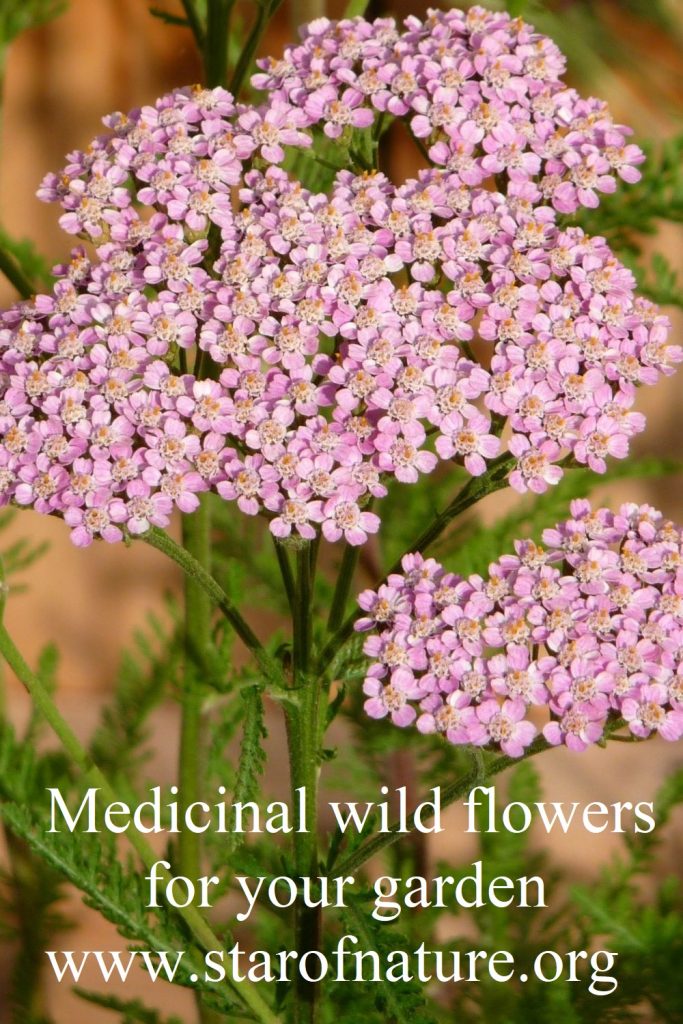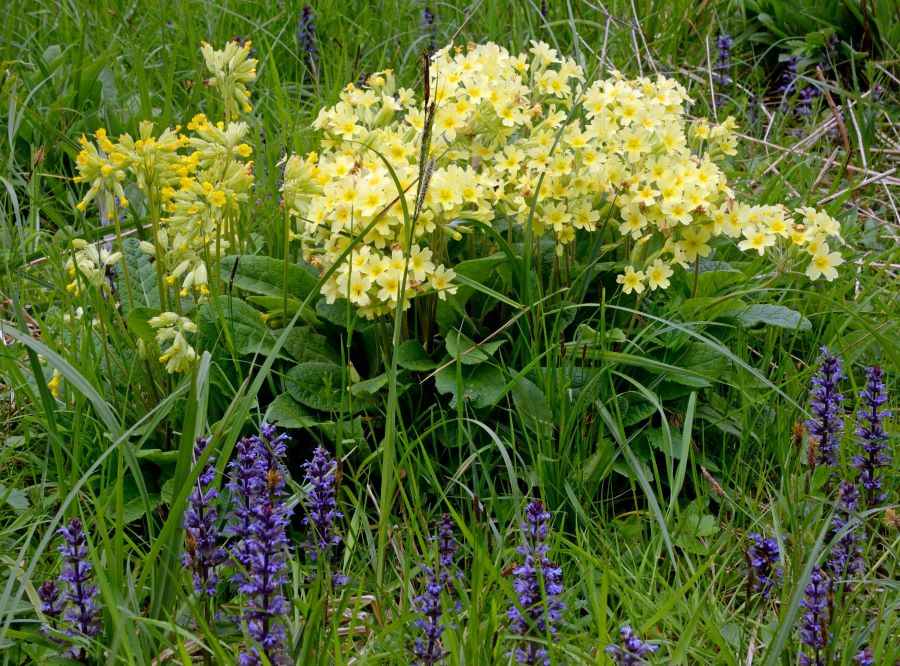Medicinal Wild Flowers for your Garden
Many wild flowers have powerful medicinal properties. For thousands of years they have been used successfully not just to increase wellbeing, but to treat most serious medical conditions. Research suggests that, when used correctly, some are just as effective as modern medicines and have fewer negative side effects. Their action tends to be gentler than that of synthetic medication.
Since plants have such powerful properties, it is dangerous to use them without comprehensive knowledge and experience. It is a mistake to think that if a substance is natural and apparently non-toxic, it can cause no harm. In order to use herbal medicines, supervision of an experienced herbalist is essential.
It is, however, rewarding and empowering to learn about medicinal plants and the history of their use. And this is something anyone can do. It can be also a start of a road towards becoming an expert herbalist.
An essential first step in learning about medicinal plants is to be able to identify them and know about the conditions in which they grow. And there is no better way of achieving this than by cultivating them in your own garden.
By growing wild flowers we also contribute to their conservation and help insects and birds that depend on them. And both the flowers themselves and animals that co-exist with them are under threat from the loss of habitats and pollution of the countryside from intensive agriculture.
Eight wild flowers with medicinal properties
All plants in the list below have outstanding medicinal properties and a long history of medical use. At the same time they all can double as decorative plants. They are beautiful and will look great in borders in the garden and in flower arrangements at home.
Some of them (yarrow, for example) have named cultivars sold as decorative plants in garden centers, while others (great burnet) are favourites with upmarket florists. I did not include plants such as nettles and burdock – they have amazing medicinal properties as well, but they are perhaps not an ideal choice for a small garden.
All plants are also easy to grow. Like most wild flowers, they are resistant to pests and diseases, perfectly suited for growing organically, and will take very little of your time.
1. Chamomile
Chamomile (Matricaria chamomilla) is one of the best-known medicinal plants. It was important in ancient Greek and medieval medicine. Greek naturalist Pliny the Elder (AD 23/24-79) recommended chamomile tea as a treatment for hepatitis, and chamomile flowers boiled in olive oil as a treatment for eczema. Chamomile is still cultivated as a medicinal plant in many countries.
In the garden chamomile needs a sunny position – it is very sensitive to light. For this reason it is most commonly found in new, rather than established habitats. It typically grows on disturbed soil in open spaces, such as recent building sites. It cannot survive in grassland where it would be quickly overshadowed by faster-growing plants. It is found only where there is little competition for light, including sides of recently built roads and ploughed margins of fields.
Chamomile can grow on poor soil, but unlike many wild flowers, it enjoys soil enriched with organic matter. It is an annual and can be grown from seed, sown in spring or autumn. Add compost to beds before sowing for best results.
Chamomile flowers that are rich in essential oil, as evident in their strong scent, are used in medicine. They are collected at the start of flowering, in dry sunny weather, and dried in shade. In modern herbal medicine chamomile flowers and essential oil have many uses, most commonly as medicine for gastric disorders.
Chamomile tea
Chamomile tea is a popular drink that has calming properties and is recommended to combat overexertion, stress and poor sleep. To make tea add 1 table spoon of dried flowers to 200ml of boiling water.
See also my post about cosmetic uses of chamomile.

2. St John’s wort
St John’s wort (Hypericum perforatum) has a very wide range of uses in herbal medicine, from the treatment of tuberculosis, to heart conditions and cancer. Most commonly it is used for the treatment of gastric and liver conditions.
But the best known use of St John’s wort is as an antidepressant. Several clinical studies have demonstrated that its effectiveness is similar to that of synthetic antidepressants. And, unlike synthetic antidepressants, it rarely causes side effects – in this respect it is known to surpass man-made drugs. Because of their safety and gentle action, St John’s wort supplements are sold without prescription in pharmacies.
In the garden St John’s wort needs a sunny position, but is otherwise very undemanding. It is common and naturally grows in meadows, on edges of woods, margins of fields and sides of roads.
St John’s wort oil
This is a excellent treatment that anyone can make. St John’s wort oil has powerful healing properties and can be used for burns, cuts and bruises. In my experience any scratches that are almost inevitable when gardening and pruning prickly plants, heal very fast, almost overnight, if the oil is applied to hands before bed.
Method
1. Collect tops (about 5-7cm) of St John’s wort shoots with flowers at the start of flowering. A traditional time to do this is 24 June, the feast of Saint John the Baptist. At this time the plant’s healing properties were believed to be greatest. Unsurprisingly, it is almost exactly the date of the summer solstice, a high point in the development of summer flowering plants. Ideally collects the shoots on a sunny day before midday.
2. Put the flowering shoots in a glass jar, filling it to the top. Add any virgin (unrefined and unheated!) plant oil, such as olive oil. Make sure that the shoots are fully submerged in oil. If they have any contact with air, mold will develop and this must be avoided. Put a weight on top, if necessary, to press the shoots down.
3. Close the lid and put the jar in a fridge. The oil can be used after 4 weeks, but to make it stronger leave it for 2-3 months before filtering.
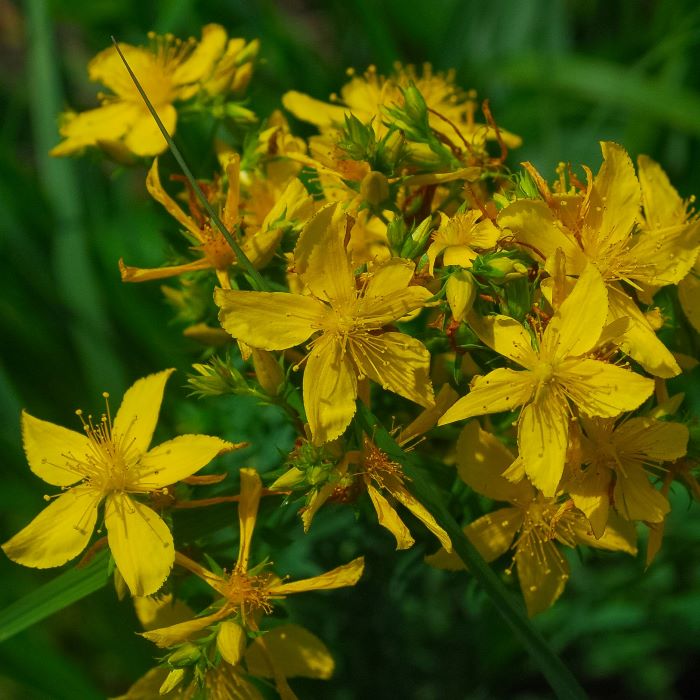
3. Elecamane
Elecamane (Inula helenium) is one of the most popular medicinal plants. It was used by physicians in ancient Greece, China and Tibet. In Europe is was grown as a medicinal plant in the Middle Ages. It appears in all medieval herbals where it is sometimes ascribed magical properties. In modern herbal medicine it is used most commonly to treat conditions affecting lungs, such as bronchitis and tuberculosis, but its uses are many, including as a treatment for allergy, sclerosis and cancer.
Elecampane is a tall (100-150cm) impressive plant, resembling a sunflower. It needs a sunny position and prefers deep, moist, neutral or alkaline soil. It is generally undemanding and makes a wonderful ‘statement’ decorative plant for the garden. It flowers in July-August and attracts numerous bees.
The root of elecampane and occasionally also leaves are used in medicine. The root is collected either in early spring before the growth starts, or in autumn after the foliage dies. It is washed, cut into small pieces and dried at a temperature no higher than 40C.
Elecampane root is also used as spice in commercial wine and desert making. It can be used to flavour sweet and savoury dishes.
See my post on the use of elecampane in cosmetics and as a spice for fruit and vegetable dishes.
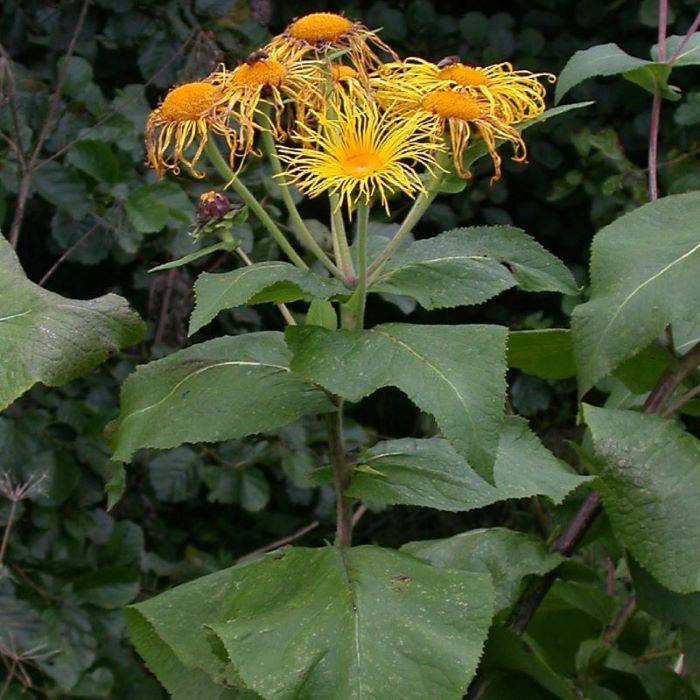
4. Valerian
Valerian (Valeriana officinalis) has a long history of use in medicine, as is evident already in its name. It is derived from Latin valere – ‘to be healthy’. Pliny the Elder believed that preparations of its root mobilize mental power and restore strength. It is indeed one of very few plants that can have a calming effect on the nervous system, without being toxic. Today it is gown commercially for medical use in many countries.
Valerian is a perennial plant, 100-150cm tall. It flowers in June -August, and is rich in nectar and attractive to bees. It naturally grows in most soil in meadows and light woodland. It is undemanding and can cope with partial shade and some dryness.
The roots of valerian are used in medicine. They are dug out in early spring before the growth starts or in late autumn when it is finished. Valerian has a short vertical root with a mass of small side roots. They are light yellow and do not have a strong smell when fresh. The familiar smell develops when they are dried – it is a result of fermentation that happens as part of drying. The roots should be dried slowly at a room temperature – this results in a stronger smell and a greater concentration of active ingredients.
The smell of valerian is very attractive to cats, so the roots or any supplements need to be kept safe out of their reach. Cats may also try to roll on plants themselves in the garden.
In herbal medicine water- and alcohol-based extracts of valerian are most commonly used to treat poor sleep, nervious system disorders and cardio-vascular conditions.
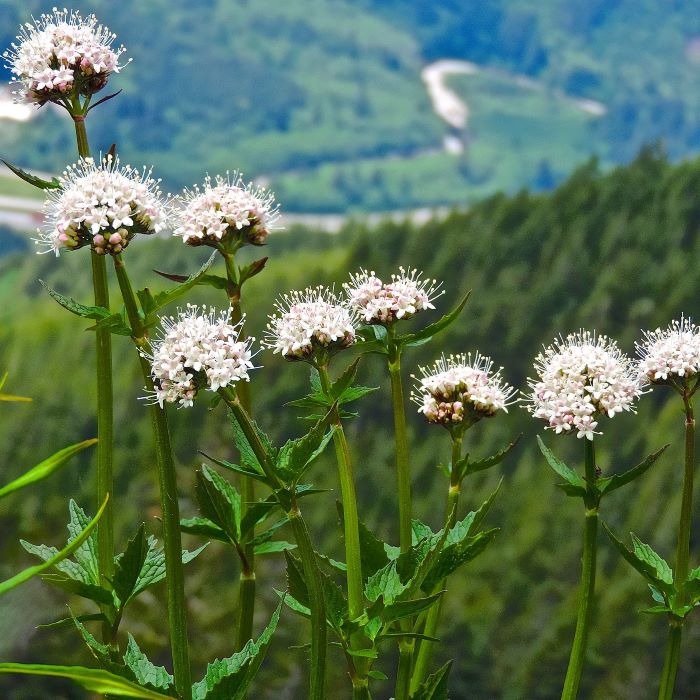
5. Cowslip
Cowslip (Primula veris) is one of the first plants to flower in spring. It is about 15-30cm tall. Its flowers have a pleasant smell resembling honey, and are very attractive to bees. Cowslip is undemanding and can be grown in the sun or partial shade.
The roots and leaves of cowslip are used in medicine. The roots are collected in autumn or early spring, washed and dried in shade. Their extracts are made into treatments for cough and bronchitis.
The leaves of cowslip contain nearly 6% of vitamin C. They are collected during flowering and dried. Dried leaves are used to make vitamin-rich tea.
Both fresh flowers and leaves have a mild taste and are excellent in salads. Their high vitamin content makes them indeed a very valuable addition to early spring salads. Flowers can be also used to decorate salads and deserts.
Cowslip salad
Combine equal amounts of grated carrot and finely chopped fresh cowslip leaves. Add a handful of pine nuts. Dress with a mixture of olive oil and lemon juice.
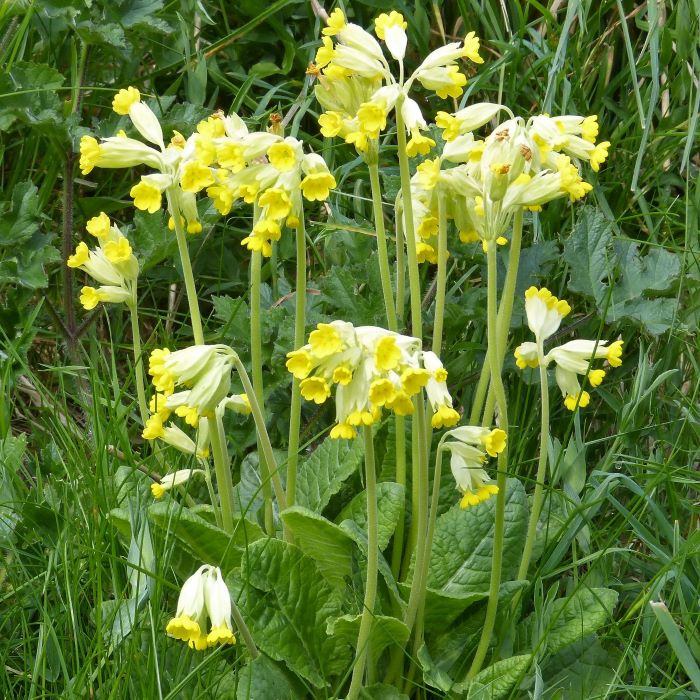
6. Yarrow
The Latin name of yarrow is Achillea millefolium. It got it from Achilles, a mythological hero of the Trojan war and one of the characters in Homer’s Illiad. Homer portrays Achilles and other Greek and Trojan warriors as having medical knowledge and being able to treat the injuries of their comrades-in-arms. He describes Achilles and other heroes using medicinal plants to treat wounds. According to a legend, the plant used by Achilles was yarrow. If this were true, it would have been a very good choice. Yarrow was used to heal wounds throughout history, in the Middle Ages, the early modern period and even during the Second World War when there was a shortage of medicines.
Yarrow indeed has outstanding healing properties. It stops bleeding just as fast as modern medicines and quickly heals wounds and cuts. It is still used in herbal medicine as a treatment for different kinds of internal bleeding. Throughout history doctors valued its ability to stop bleeding with a very low risk of developing blood clots. Yarrow has many other medical uses as well.
Yarrow is about 20-40cm tall, flowers from July to September, and is very attractive to bees and butterflies. It is usually found in meadows, the margins of fields and sides of roads. It needs full sun, but is otherwise undemanding and can grow in poor, compacted soil. Wild varieties are typically white or pale pink, but garden centers now also offer exceptionally beautiful cultivars with bright orange, red and pink flowers.
Yarrow is rich in essential oil and can be used as a spice. It has a strong pleasant smell and is used to flavour commercially made wines and liqueurs. Finely chopped young, or powdered dried leaves and flowers can be added to salads, fish, meat and vegetable dishes, and used to flavour cheeses and bread. Yarrow is, however, toxic in large quantities, so use it as a spice, rather than a vegetable.
Yarrow spice
Collect young leaves and flowers of yarrow at the start of flowering. Dry on paper in a well ventilated room. Pulverize in a mortar and put through a sieve to get rid of any remaining large fragments.
Add dried yarrow powder (or fresh finely chopped flowers and leaves) to a meat or vegetable casserole five or ten minutes before it is ready. Use 1 teaspoon of powder or 2 teaspoons of fresh chopped leaves and flowers to a casserole for 3-4 people.
See also my post about cosmetic uses of yarrow.
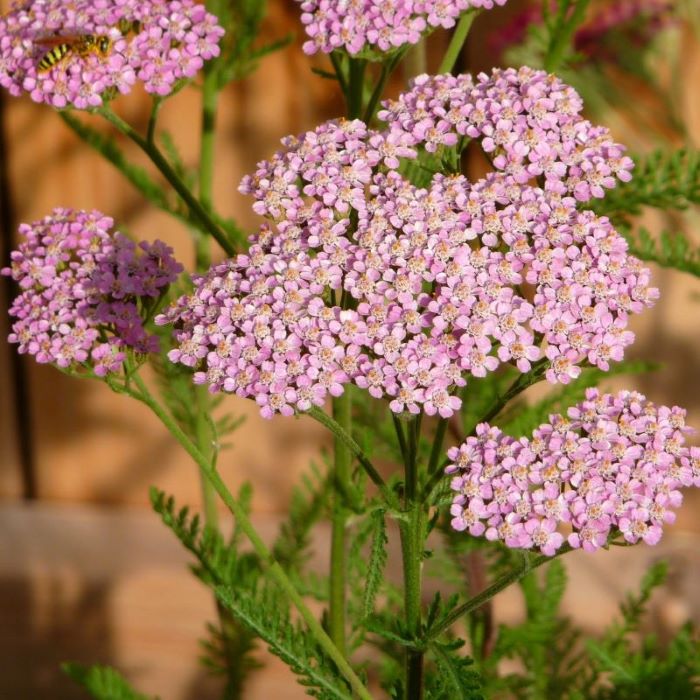
7. Wild strawberry
Wild strawberry (Fragaria vesca) is one of the most medicinal wild berries. It is a small plant, only 2-15cm tall. It flowers in May and produces fruit in June and July. It grows in gardens and sunny clearings in woods.
Wild strawberry is extremely versatile and does well in a surprisingly broad range of conditions. It grows on acidic and alkaline, rich and poor soils, and can cope with moist conditions as well as prolonged periods of dryness.
Berries and leaves, collected at the same time, are used in medicine. Fresh fruit, and dried fruit and leaves, are made into treatments for a wide range of conditions, including arthritis, eczema and allergies.
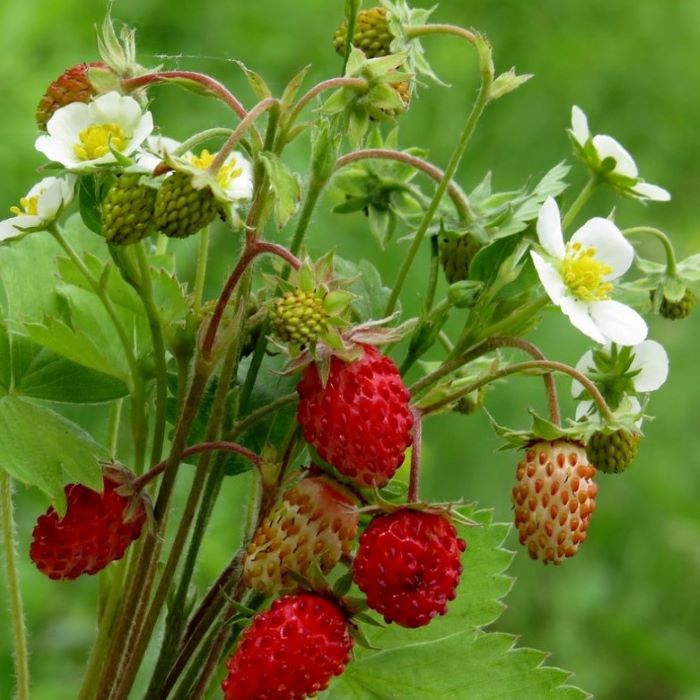
8. Great Burnet
Great burnet (Sanguisorba officinalis) grows in meadows, on edges of woods and banks of rivers. Its forms dense clumps of highly divided leaves with flower stalks growing over a meter tall. It flowers from July till September, and is rich in nectar and very attractive to bees. It prefers a sunny position and a relatively moist soil.
The roots of great burnet are used in medicine. They are dug out in late autumn and early spring, washed and dried. Traditionally they are dried on wood, rather than metal surfaces – they are believed to loose their medicinal properties in contact with metal.
True to its Latin name sanguisorba (‘absorbing blood’), great burnet has been used to stop bleeding and to treat wounds. In modern herbal medicine it is used for internal bleeding, dysentery, salmonella infection, cancer and other illnesses.
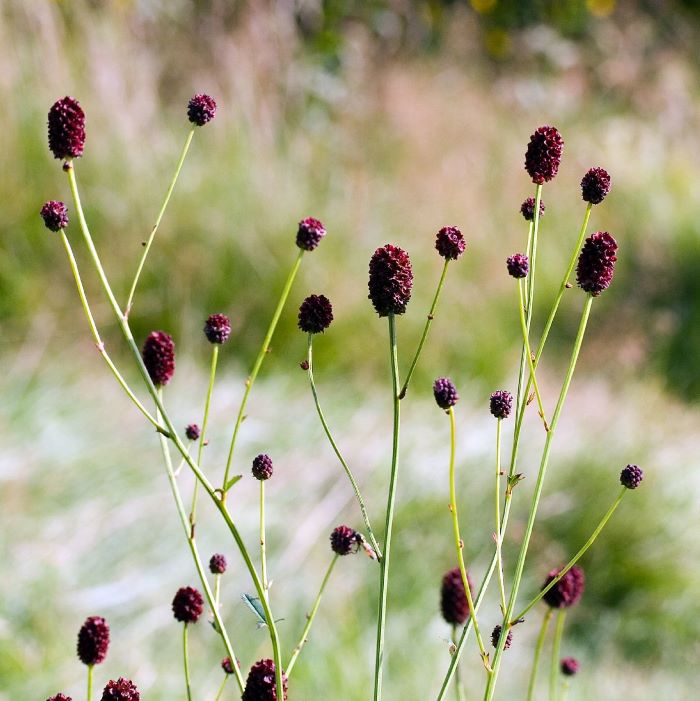
Image credits: chamomile by Hans Splinter, St John’s wort by Joshua Mayer, elecampane by Len Worthington, valerian by Peter Stevens, cowslip by Gailhampshire, yarrow by B.D.’s world, wild strawberry by Valdemar Fishmen.
Posts related to ‘Medicinal Wild Flowers for your Garden’
How to Grow Wild Flowers in the Garden
Best wild flowers to grow in the garden
Best Wild Flowers for Bees and Butterflies
45 Edible Flowers for Baking, Cakes, Cocktails, Salads and More
Small Scale Rewilding: How to Rewild your Garden
What is Nectar: Basics for a Bee-Lover
What is Pollen: Basics for a Bee-Lover
Pin ‘Medicinal Wild Flowers for your Garden’ for later
